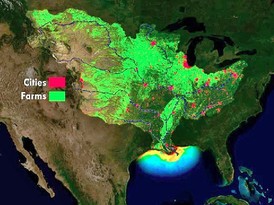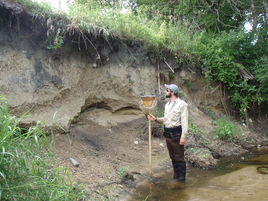|
The federal Clean Water Act Section 319 funding round is now
open, with $1.4 million expected for grants to reduce water pollution. The
Minnesota Pollution Control Agency (MPCA) administers this program, which
provides funding and technical assistance to groups and individuals who work with
citizens to reduce non-point source pollution.
To be eligible, projects must be implemented in watersheds
with a Total Maximum Daily Load (TMDL) approved by the U.S. Environmental Protection
Agency (EPA) by the close of the application period, which is March 2 this year.
Projects may include conservation practices that directly reduce non-point
source pollution, and any associated education or development activities.
Visit the MPCA website
for more information and application instructions.
The MPCA invites the public to make comments on the agency’s
draft air quality permit, draft water quality permit and draft 401
certification for the Poly Met Mining, Inc., (PolyMet) NorthMet mining project.
The draft permits and related support documents are on the MPCA’s NorthMet
project webpage.
The public comment period is open today, Jan. 31 through
March 16. Public comments can also be given at one of two public meetings
scheduled in February. The MPCA and DNR will jointly hold
public meetings on the draft permits at the following locations:
All comments received during the comment periods are
considered when the MPCA decides whether to issue a permit or certification.
Comments can and often do result in changes to the final permit.
Proposed NorthMet project
The proposed NorthMet Project, located near the cities of
Hoyt Lakes and Babbitt in northeastern Minnesota, would create an open pit
copper, nickel, cobalt and precious metals mine with stockpile areas. It would
also refurbish a portion of the former LTV Steel Mining Company (LTVSMC)
processing plant, construct a new hydrometallurgical facility, construct a
tailings basin facility on the site of LTVSMC existing tailings facilities, and
add to existing utility infrastructure and rail lines.
Before proceeding with the proposed NorthMet Mining Project,
PolyMet must obtain permits from MPCA as well as other state, federal, and
local permits and approvals. The steps in the permitting process are identified
on the MPCA’s PolyMet webpage.
The draft air permit is a regulatory document that contains
legally enforceable requirements. A permit identifies the units at each
facility that generate air pollutants, details the conditions under which the
facility must operate to comply with rules and regulations and, where
applicable, sets limits on those emissions.
The draft water quality permit (or more formally, a National
Pollutant Discharge Elimination System/State Disposal System or NPDES/SDS
permit) establishes specific limits and requirements to protect Minnesota's
surface and groundwater quality for a variety of uses, including drinking
water, aquatic life and recreation.
The draft 401 certification is a water quality certification
from the state that would become a part of the U.S. Army Corps of Engineers’
Section 404 permit. In the 401 certification, the state reviews the proposed
activity in order to determine if it will comply with applicable water quality
standards, and identifies any conditions needed to ensure compliance. If the
review finds that water quality will be protected, the 401 certification is
issued and the certification and conditions become part of the 404 permit.
Submitting public comments
The MPCA will accept comments Jan. 31 - March 16. Starting today, comments can be submitted online
via the state agency Polymet portal.
Comments can also be mailed to:
Minnesota Pollution Control Agency
PolyMet Draft Permit
Comments
520 Lafayette Road
North
St. Paul MN
55155-4194

The Legislative- Citizen
Commission on Minnesota Resources recently opened its funding round for projects
of all sizes that aim to protect, conserve, preserve, and enhance Minnesota’s
air, water, land, fish, wildlife, and other natural resources. About $59
million is anticipated to be available for projects beginning July 1, 2019.
Most projects funded are 2-3 years in duration. Applicants are encouraged to
submit draft proposals by March 14 to receive staff feedback. Final proposals
must be submitted online by April 11.
The funding derives from
the Environment and Natural Resources Trust Fund, which is funded with
Minnesota Lottery and investment proceeds. The commission is responsible for
making funding recommendations to the Minnesota Legislature.
|
 Under an agreement between the Minnesota Dept. of Agriculture (MDA) and the Barataria-Terrebonne National Estuary Program in Louisiana, eligibility for Agricultural Best Management Practices (AgBMP) loans in Minnesota will be expanded to include larger livestock operations.
With Minnesota’s formal recognition of the Barataria-Terrebonne management plan, eligibility will be expanded to include livestock operations holding National Pollution Discharge Elimination System (NPDES) permits or those operations with more than 1,000 animal units.
The dead zone, an area with low to no oxygen that occurs in the Gulf of Mexico each summer off Louisiana and Texas, kills fish and other marine life that fail to move out of the affected waters. Last year, it spanned a record 8,776 square miles, about the size of New Jersey, researchers said.
Since its inception in 1995, the MDA AgBMP Loan Program has issued more than 13,000 low interest loans to Minnesota businesses and landowners financing over $220 million for projects addressing erosion, runoff, manure management, septic treatment, and drinking water problems.
|

The Marsh
River watershed in northwest Minnesota is home to more than 36 fish species
and 119 different macroinvertebrates, also known as aquatic insects. This watershed drains a total of 362 square
miles, spanning across Norman and Clay counties. The abundance and diversity of
aquatic life in the Marsh is due in part to the river’s close connection to the
Red River of the North. Together these streams function as an interconnected
system to provide crucial habitat for many species.
The Marsh River watershed gets its name from the vast
prairies and numerous shallow wetlands that once dominated its landscape. Early
settlers took advantage of the soils left by ancient Lake Agassiz to grow crops
and raise livestock. People made extensive alterations to the landscape and
streams to enhance farming even further. About 67% of the streams within the
watershed have been altered, including all tributaries on the Minnesota side.
The Marsh River is the only remaining natural watercourse in the entire
watershed.
As part of monitoring and assessment work done in the
watershed, the MPCA studied six sections of the Marsh River. Four sections
fully supported fish and aquatic insect life, while two did not. The main
contributors to aquatic life impairments include:
- Degraded habitat
- Extended periods of insufficient flow
- Excessive sediment clouding the water
The Marsh River is also impaired for swimming, meaning
bacteria levels are too high at times to meet the standard designed to ensure
safe contact with the water.
The diversity of life in the Marsh River system is worth
protecting and restoring. However, there are some major impediments to
restoring conditions that fully support aquatic life. Drainage ditch networks
impede the natural fish runways from the Red River and threaten the ability of
these fish to reach the Marsh River and its tributaries. Another barrier to
fish passage is the high gradient culvert at the confluence of County Ditch 11
and the Marsh River.
Drainage of the tributaries within the Marsh River watershed
is so effective that most of the tributaries go dry during the summer months.
Heavy silt deposits and poorly formed streams were also
noted at each monitoring station.
Protecting and restoring habitat for greater diversity of
aquatic life will depend on:
- Establishing ways to control drainage while
allowing streams to retain water
- Removing barriers to fish passage
- Creating buffers around all streams, rivers, and
ditches using native perennial vegetation and trees
The loss of consistent flows in the watershed has been
detrimental to habitat for fish and aquatic insects, but data suggest restoring flows has the potential for correcting
this problem.
Excessive sedimentation exists in areas used by
gravel-spawning fish and aquatic insects. Sediment clouds the water and makes
it difficult for fish and other aquatic life to breathe, find food, and
reproduce.
Although impairments have been identified throughout the
watershed, the Marsh and its tributaries do in some places support extensive fish and aquatic insect populations. These
places need protective strategies to maintain their conditions.
For more details of the river’s ability to support aquatic
life and recreation, see the full Marsh
River Watershed Monitoring and Assessment Report on the MPCA website.
|

The Minnesota Department of Agriculture (MDA) and Board of
Water and Soil Resources (BWSR) reports that their Root River Field to Stream
Partnership with local farmers is reducing soil loss and protecting water
quality. Nearly 100% of farmers in the Root River study area have participated
in a field walkover to identify those areas most susceptible to sediment and
nutrient loss. In just two years, more than 60%of those farmers have installed
or fixed conservation practices in their fields to reduce these losses.
As a result of the field walkovers, a total of 40 new
conservation projects have been completed with several more projects planned
through 2019.
“This project exemplifies where local conservation partners
like Soil and Water Conservation Districts excel,” said John Jaschke , BWSR executive director. “They know
the landscape, understand the importance of agriculture to the local
communities, and are able to make the connection between what the data is
telling us, what is happening on the ground, and how to find solutions that
work for everyone involved.”
The work is the result of strong relationships with area
farmers and an intense surface and groundwater monitoring program. Seven years
of baseline water quality data has allowed researchers to identify the critical
timing of loss as well as the amount of sediment and nutrients leaving fields.
Water quality measurements are taken at both the edge of agricultural fields
and in nearby streams.
Monitoring will continue over the next several years to
evaluate the effects of these conservation practices at both the field and
small watershed scales.
Funding came from several sources, including the Legacy
Amendment. For details, see the BWSR
website.
Next month's Waterfront Bulletin: Meet a farm family who participated in the study.
|
 Fish in the water, and paddlers on the water, will appreciate the re-establishment of a rock riffle in the Minnesota River just below the state Highway 212 bridge in Granite Falls.
With the earlier removal of the old Minnesota Falls dam downstream, the lower water level revealed rock-filled cribbing left over from a dam dating back to the late 1800s. Newly-exposed it created problems for paddlers and fish migration. In December the DNR completed for the most part restoration to a more natural state. (Photo at right: Looking east below the Highway. 212 bridge.)
"We anticipate completing some final survey work during warmer weather; however, we do not anticipate the need for any further construction activity on the riffle," says Chris Domeier, Ortonville Area Fisheries Manager in the DNR Division of Fish and Wildlife. "This is the best lake sturgeon spawning habitat in the Minnesota River. This site is good for fish, but more importantly even better for anglers and boaters."
The Willmar West Central Tribune reported: High water flows in the river had delayed the project for nearly two years. The U.S. Army Corps of Engineers held water back at Lac qui Parle Lake to aid the work this season. A grant from the Lessard Sams Outdoor Heritage Fund made the project possible, said Domeier, in large part because of the benefits it will provide for fish in the river.
Dr. Luther Aadland with the Minnesota DNR, who has built an international reputation for restoring fish habitat when dams are removed from riverine systems, oversaw the restoration. Its goals are to restore the spawning habitat needed by the river's rock stars: Lake sturgeon, paddlefish, walleye, and sauger among them.
|
The MPCA is considering an update to its water fees and has created the Water Fee Advisory Committee to provide input to MPCA Commissioner John Linc Stine on this important topic. An orientation meeting of the Water Fee Advisory Committee was held on Jan. 8 at the MPCA St. Paul office. The Advisory Committee plans to meet monthly through June 2018. Meetings will be held at the MPCA St. Paul office and are open to the public. Information about meeting dates, agendas, notes, and related materials will be available on the Water Quality Fee Rule webpage. The webpage also contains information about the water fees.
 We Are Water MN, a traveling exhibit, is on display through March 12 in the State Capitol’s East Corridor, ground level. You can visit it any time the capitol is open to the public. The exhibit will stop at nine other locations in 2018 and 2019.
We Are Water MN explores the connection between the humanities and water through a hands-on exhibit. Visitors reflect on local stories and the meaning and experiences of water in Minnesota with a space to add their own stories.
Listen to stories from parents, children, fishers, famers, indigenous Minnesotans, immigrants to Minnesota, water professionals, and people who just love to be out on the lake.
We Are Water MN is led by the Minnesota Humanities Center, in partnership with the MPCA, Minnesota Historical Society, and Minnesota DNR, Health, and Agriculture.
- March 19-June 18: Clay County Historical and Cultural Society, Moorhead.
- Oct. 14-Nov. 26: University Institute for Advanced Study, Minneapolis.
- Dec. 2-Jan. 14, 2019: Headwaters Science Center, Bemidji.
- Jan. 20-March 4, 2019: Polk County SWCD, Crookston.
- March 10-April 22, 2019: Fond du Lac Band, Cloquet.
- April 28-June 16, 2019: Cedar River Watershed District, Austin.
- June 20-July 28, 2019: Cannon River Watershed Partnership, Northfield.
- Aug. 4-Sept. 16, 2019: Itasca Waters, Grand Rapids.
- Sept. 22-Nov. 4, 2019: Mille Lacs Indian Museum, Onamia.
|
The U.S. EPA recently approved the TMDL
report for Miller Creek, a well-known trout stream flowing through Duluth
and Hermantown in northeast Minnesota. Unfortunately, the creek has suffered
from urban influences for many decades. As Miller Creek winds its way to the
St. Louis River, fewer shade trees and plenty of stormwater runoff from roads
and parking lots create warmer water that trout, other cold-water fish and bugs
don’t appreciate. Shading the creek, restoring more natural flow paths, and
preventing warm stormwater from entering it are possible strategies to address
the temperature problem.
Experts from across
the United States will present the latest research and innovations in road salt
application and its effects on lakes, rivers, and streams to an expected 270
participants at the 17th Annual Road Salt Symposium in Plymouth, Minn. on Feb.
8. Freshwater Society, in coordination with Fortin Consulting, organizes the
annual event to increase awareness of cutting-edge maintenance techniques for
snow and ice management that minimize the effects road salt and other winter
maintenance practices pose to freshwater resources.
Freshwater will also
present Environmental Leadership Awards to several organizations and
individuals for their efforts to change winter maintenance practices or
educational programs to have less impact on our environment. Among them is Brooke
Asleson, MPCA watershed project manager, for her exceptional leadership at
the MPCA in researching and developing the Twin City Metropolitan Area Chloride
Management Plan. Asleson engaged more than 100 stakeholders over
seven years to inform the plan. She also worked with Fortin Consulting to
develop a first-of-its-kind Winter Maintenance Assessment Tool to reduce salt
use.
 An administrative law judge recently rejected the MPCA’s proposed changes to the standard to protect wild rice. The existing rule (or standard) limits sulfate to 10 milligrams per liter in water used for the production of wild rice. However, the MPCA’s new research indicates that sulfide – converted from sulfate by bacteria - in the sediment in which wild rice grows is the pollutant of concern. The proposed rules are designed to limit sulfide to 120 micrograms per liter. The proposed changes would have established a process to identify the level of sulfate that would be protective for each wild rice water body. The proposal would have also identified wild rice waters in Minnesota.
The MPCA is now evaluating all available options following the ruling.
“While we are disappointed with the ALJ disapprovals in the report, we are pleased that the ALJ agreed the proposed revisions were based on sound scientific evidence,” the agency said in a statement issued to media.
“At the Legislature’s direction, the MPCA worked diligently for nearly seven years to craft a modern, workable rule that would protect wild rice from the impacts of sulfate pollution. We strongly believe that those efforts delivered a solution that would effectively protect this important resource, while providing a workable standard for businesses and industries that would be impacted by these regulations.
“Significant input, including 4,500 public comments received through a 93-day open public comment period and six public hearings, informed numerous appropriate adjustments to the proposed rule revision.
“In light of the ALJ report, MPCA now intends to proceed with the rule revision process, as prescribed by Minnesota state law. We will first submit a comprehensive written response to the ALJ report. The Chief ALJ will then review our response and determine if the modified proposal is acceptable. We believe this exchange can lead all parties to a workable solution, and we remain strongly committed to achieving that ideal outcome.
“The Minnesota Legislature shares a keen interest in this matter and we look forward to working with legislators and the public as we continue to refine an improved rule proposal.”
Related media coverage:
|
|